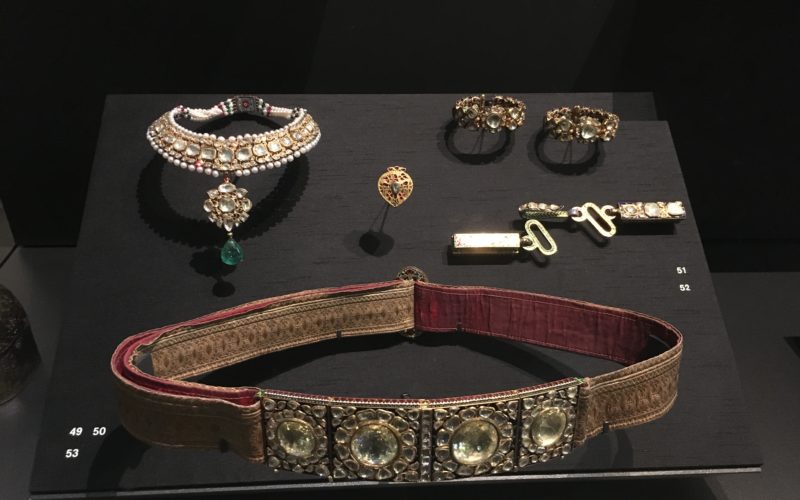Manchester Museum is undergoing a huge expansion at the moment, if you’ve visited recently you’ll notice the old entrance is now a building site, and that the amazing Egyptology department is temporarily closed. When all the work is complete, the museum will have a brand new entrance, a new exhibition hall, a new Chinese Culture Gallery and a new South Asia Gallery, all due to be completed in 2021.
This expansion is about more than just new architecture, and a lot of thought went into what the new galleries will represent for visitors, and for the wider Manchester communities.
Last year, I joined a group of other people from the Manchester community, who have links to South Asia, to became a co-curator for the new South Asia Gallery.
So what even *is* a co-curator?
This is a question I found myself asking when attending some of the earlier meetings for this project. What do we actually do? In the most simplistic terms, we’re working with the Museum’s teams to help shape what goes into the new gallery, what stories we think should be shared, how the gallery should look and feel.
This is the first time Manchester Museum have created one of their galleries in this way – with so much input from the community. Some of the themes we’re looking at include journeys and migration, South Asia’s contributions to science and mathematics, what it means to be Brit-Asian, Music and area I’m most interested in – Arts and Culture.
My Story – A Celebration of South Asia’s Gems and Jewels
What I would most love to see in the new South Asia Gallery, is a celebration of the historical gems and jewellery from pre-partition India. My fascination with India’s jewels and gems really started in 2016 when I was visiting the Victoria and Albert Museum in London. I came upon an exhibition called “Bejeweled Treasures: The Al Thani Collection” and decided it was worth a visit. Inside, I saw a dazzling display of diamonds, gold, rubies, emeralds, jade and other precious items dating back to the Mughal Empire in India.
I sneakily (because no photos allowed!) took the below pic and shared it on my Instagram at the time!
View this post on Instagram
My interest wasn’t just in the beautiful jewels themselves, but in how this exhibition came together in the first place. How had these very precious items survived through the centuries? What happened to the people who had these treasures made? Why was it called the Al Thani collection??
It turns out, Al Thani is the name of the ruling family of Qatar. A member of this family, like me, was drawn to these amazing jewels and their history, but unlike me, they happened to have the money and resources to search for and buy these items.
On the one hand, I was sad, that these items, which are an important part of India’s history, were now owned privately. Whilst on the other hand, I was happy that the Al Thanis had decided to display their private collection in a public museum (for a small entry fee!).
The Al Thani Jewels 100 Million Dollar Auction
Fast forward to 2019, and I was reminded of this exhibition again, when it was announced that the Al Thani Foundation was auctioning off just under 400 items in a collection entitled “Maharajas & Mughal Magnificence”. The auction included many of the items I’d seen at the V&A years earlier.
The auction itself raised around 109 Million Dollars! Check out this short video clip for the highlights.
It actually made me a little sad to think that now these items were sold, they would go back to being unseen in private collections. These amazing historical items from South Asia’s heritage locked away for very few to appreciate.
British Museum’s Collections of Jewels and Gems from India
There are of course other precious items from South Asia’s history, the Al Thani family didn’t acquire all of them! Perhaps the most famous example is the Koh-I-Noor diamond which sits in the Tower of London as part of the crown jewels. Many other museums and galleries have Indian gems in their collections – including the British Museum, who happen to be a big part of Manchester Museum’s plans for the new South Asia Gallery.
Fab visit to @britishmuseum today, in search of inspiration for the new South Asia Gallery @mcrmuseum. My particular interest is in the Mughal Empire & I was ? at the beautiful items they made out of gold, diamonds, rubies, emeralds pearls and jade! pic.twitter.com/1sufoxNKpE
— nazma (@nazma_knows) November 30, 2019
Manchester Museum and the British Museum are working together on the new gallery and this includes being able to borrow some of their items. As part of the project, I got the opportunity to visit the British Museum with the Manchester Museum team and to get a feel for how their collections could form part of my idea.
That’s as far as I’ve come so far as a co-curator, and I’m really looking forward to following the project through.
Ultimately, I would love to see a collection of beautiful amazing gems and jewels from historical South Asia, proudly displayed in the new South Asia Gallery. I want visitors to be thinking about and having conversations about how these came into the UK, and into museum collections. And whilst I’m here writing a wishlist…if I ever get the opportunity, I would absolutely LOVE to try on even the smallest of these magnificent diamonds/rubies/emeralds!
You can find out more about the new South Asia Gallery over at Manchester Museum’s Hello Future blog.
If you’re into these gems as much as I am, I’d also recommend reading William Dalrymple and Anita Anand’s book:
Koh-I-Noor: The History of the World’s Most Infamous Diamond.

Such a fantastic inspiring and thought provoking blog Nazma!!
Throughly enjoyed reading and watching the Christie’s video!
Can’t wait to see how your co.curated space pans out!